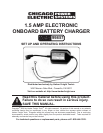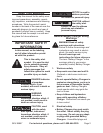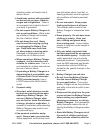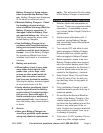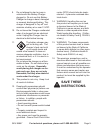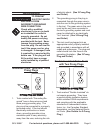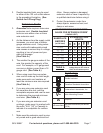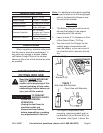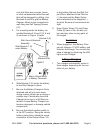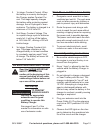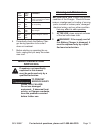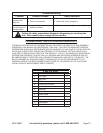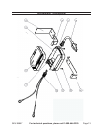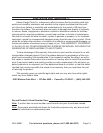SKU 99857 For technical questions, please call 1-800-444-3353. Page 3
matching outlets will reduce risk of
electric shock.
Avoid body contact with grounded b.
surfaces such as pipes, radiators,
ranges and refrigerators. There is
an increased risk of electric shock if
your body is grounded.
Do not expose Battery Chargers to c.
rain or wet conditions. Water enter-
ing a Battery Charger will increase
the risk of electric shock.
Do not abuse the cord. Never d.
use the cord for carrying, pulling
or unplugging the Battery Char-
ger. Keep cord away from heat,
oil, sharp edges or moving parts.
Damaged or entangled cords in-
crease the risk of electric shock.
When operating a Battery Charger e.
outdoors, use an extension cord
suitable for outdoor use. Use of a
cord suitable for outdoor use reduces
the risk of electric shock.
If operating a Battery Charger in a f.
damp location is unavoidable, use
a Ground Fault Circuit Interrupter
(GFCI) protected supply. Use of
a GFCI reduces the risk of electric
shock.
Personal safety3.
Stay alert, watch what you are do-a.
ing and use common sense when
operating a Battery Charger. Do
not use a Battery Charger while
you are tired or under the inuence
of drugs, alcohol or medication. A
moment of inattention while operating
Battery Chargers may result in seri-
ous personal injury.
Use personal protective equip-b.
ment. Always wear eye protection.
Safety equipment such as dust mask,
non-skid safety shoes, hard hat, or
hearing protection used for appropri-
ate conditions will reduce personal
injuries.
Do not overreach. Keep proper c.
footing and balance at all times.
This enables better control of the
Battery Charger in unexpected situa-
tions.
Dress properly. Do not wear loose d.
clothing or jewelry. Keep your
hair, clothing and gloves away
from moving parts. Loose clothes,
jewelry or long hair can be caught in
moving parts.
Only use safety equipment that e.
has been approved by an appropri-
ate standards agency. Unapproved
safety equipment may not provide
adequate protection. Eye protection
must be ANSI-approved and breath-
ing protection must be NIOSH-ap-
proved for the specic hazards in the
work area.
Battery Charger use and care4.
Do not force the Battery Charger. a.
Use the correct Battery Charger
for your application. The correct
Battery Charger will do the job better
and safer at the rate for which it was
designed.
Disconnect the plug from the pow-b.
er source from the Battery Charger
before making any adjustments,
changing accessories, or storing
Battery Chargers. Such preventive
safety measures reduce the risk of
starting the Battery Charger acciden-
tally.
Store idle Battery Chargers out of c.
the reach of children and do not
allow persons unfamiliar with the



